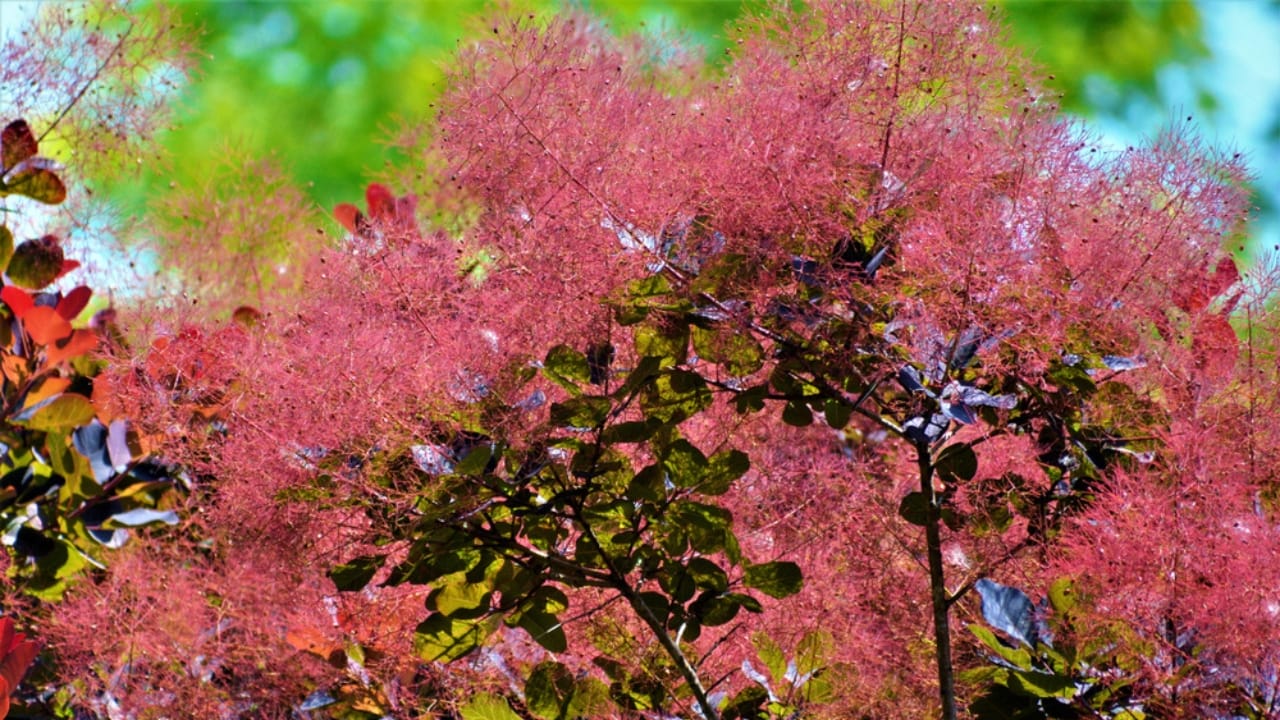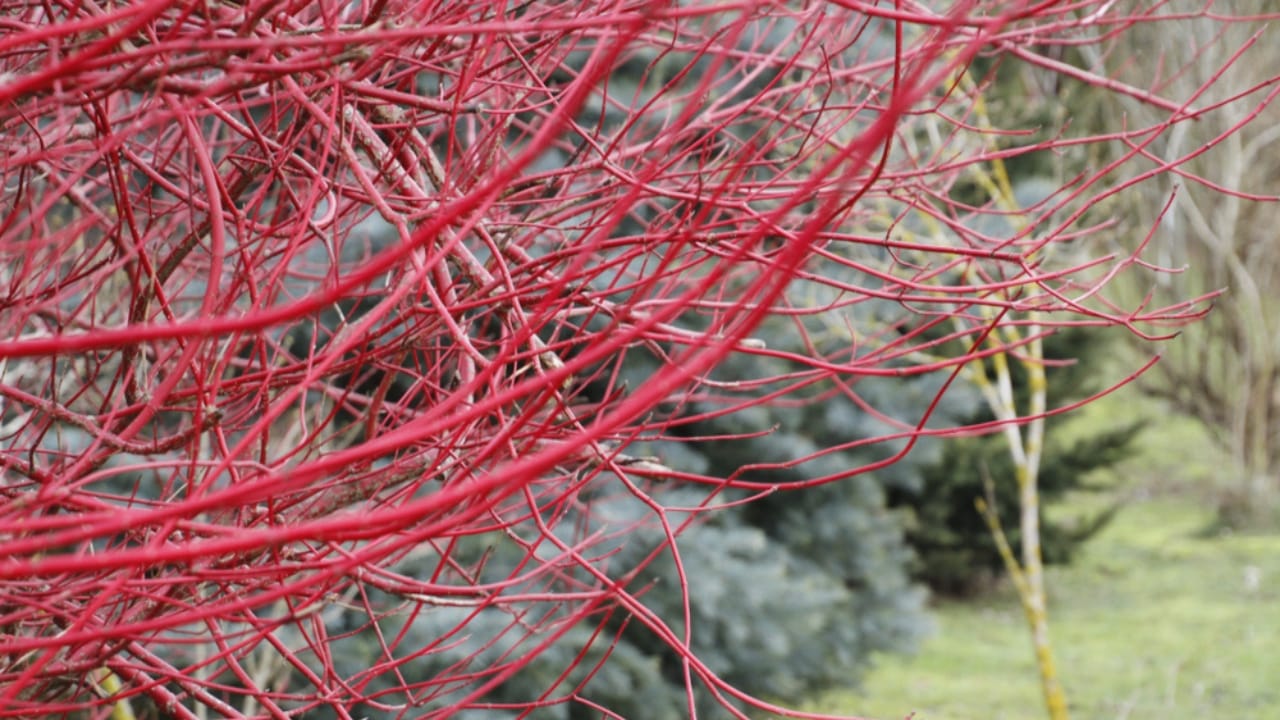As the warm days of summer fade into the crisp, cool air of autumn, the landscape transforms into a kaleidoscope of vibrant hues. While trees often steal the show with their fiery display, shrubs can be your yard’s unsung heroes of fall color.
From the classic burning bush to the oakleaf hydrangea, these 12 shrubs offer a range of sizes, shapes, and colors to suit any garden style.
1. Burning Bush (Euonymus alatus)

Burning bush is a classic choice for fall color, and for good reason. This slow-growing, compact shrub boasts dark green leaves that transform into a brilliant rose-red in autumn.
Its dense, twiggy habit makes it an excellent choice for hedges or screens, growing 6-8 feet tall and 5-6 feet wide in partial to full shade.
While burning bush is undeniably beautiful, it has been deemed invasive in some areas due to its ability to spread rapidly.
If you’re looking for an eco-friendly alternative, consider one of the other stunning shrubs on this list.
2. Virginia Sweetspire (Itea virginica)

Virginia sweetspire is a versatile native shrub with multi-season interest, including spectacular fall color. In autumn, its glossy green leaves turn a vibrant red to scarlet, often holding their color well into November or even December.
This low-maintenance shrub is adaptable to a range of soil types and moisture levels, making it a great choice for tough spots in the landscape. It typically grows 3-5 feet tall and wide, depending on the cultivar.
Virginia sweetspire produces fragrant, white bottlebrush-like flowers that attract pollinators in late spring to early summer.
3. Oakleaf Hydrangea (Hydrangea quercifolia)

Oakleaf hydrangea is a stunning native shrub that offers year-round interest, including incredible fall color. In autumn, its large, oak-like leaves turn a rich burgundy to red, creating a dramatic display against its exfoliating cinnamon-brown bark.
This low-maintenance shrub prefers rich, well-drained soil and partial shade, growing 4-15 feet tall and wide depending on the variety. In early summer, oakleaf hydrangea produces large, cone-shaped clusters of white flowers that gradually turn pink as they age.
Its attractive foliage, showy flowers, and impressive fall color make it a must-have for any garden.
4. Cutleaf Staghorn Sumac (Rhus typhina ‘Dissecta’)

Cutleaf staghorn sumac is an exceptional variety of the native staghorn sumac, renowned for its brilliant fall color and unique form. This large shrub can reach an impressive 9-15 feet tall and 15-20 feet wide, making it a striking addition to any landscape.
In autumn, the deeply serrated, compound leaves of cutleaf staghorn sumac turn a stunning array of colors, ranging from bright yellow to vivid orange and deep red.
While some may consider sumacs aggressive spreaders due to their ability to form dense thickets through suckering, this trait makes them excellent choices for naturalizing or erosion control.
5. Red Osier Dogwood (Cornus sericea)

Red osier dogwood, also known as red twig dogwood, is a native shrub that offers a unique twist on fall color. While its leaves do turn a reddish-purple in autumn, its true claim to fame is its brilliant red stems that are revealed when the foliage drops.
This adaptable shrub grows best in moist soils and can reach 6-9 feet tall and wide. In late spring, it produces small, white flowers that give way to white berries, attracting birds and other wildlife.
Red osier dogwood’s striking stem color and ability to thrive in wet areas make it a valuable addition to the winter landscape.
6. Spicebush (Lindera benzoin)

Spicebush is a native shrub that offers a feast for the senses in fall. Its aromatic leaves turn a beautiful yellow to golden-yellow in autumn, and its small, red fruits are a favorite of birds.
This understory shrub grows 6-12 feet tall and wide and prefers moist, well-drained soils and partial shade. In early spring, before the leaves emerge, Spicebush produces small, yellow flowers, an important nectar source for early pollinators.
Its multi-season interest, wildlife value, and adaptability make Spicebush a must-have for naturalistic landscapes.
7. Highbush Blueberry (Vaccinium corymbosum)

Highbush blueberry is a native shrub that offers a winning combination of ornamental value, stunning fall color, and delicious fruits. In autumn, its leaves turn a beautiful range of hues, from yellow and orange to red and purple, creating a vibrant display in the landscape.
This low-maintenance shrub prefers acidic, well-drained soils and thrives in full sun to partial shade. Highbush blueberry typically grows 6-12 feet tall and wide, making it a versatile choice for hedges, borders, or as a specimen plant.
In spring, highbush blueberry produces clusters of white or pink bell-shaped flowers that attract pollinators. These flowers give way to the tasty, nutrient-packed blue fruits in summer, which are delicious for humans and provide food for wildlife.
8. Ninebark (Physocarpus opulifolius)

Ninebark is a tough, adaptable native shrub with a unique fall color. Its lobed leaves turn shades of yellow, bronze, and red in autumn, often with a mix of colors on the same plant.
This low-maintenance shrub grows 5-8 feet tall and wide, tolerating various soil types and light conditions. In late spring to early summer, ninebark produces clusters of small, pink, or white flowers that give way to red fruits.
Its peeling bark adds winter interest, making it a year-round addition to the landscape.
9. American Beautyberry (Callicarpa americana)

American beautyberry is a native shrub with a unique twist on fall color. While its leaves turn a beautiful yellow to gold in autumn, its true claim to fame is the clusters of bright purple berries that persist into winter, adding a pop of color to the landscape.
This adaptable shrub grows 3-6 feet tall and wide, making it a versatile choice for borders, hedges, or as a specimen plant. American beautyberry prefers moist, well-drained soils and thrives in partial shade, although it can tolerate various light conditions.
In summer, American Beautyberry produces small, inconspicuous pink flowers that give way to the eye-catching fruits in fall. The berries are visually striking and provide a valuable food source for birds and other wildlife during the colder months.
10. Witch Hazel (Hamamelis spp.)

Witch hazels are a group of native shrubs that offer a unique display of fall colors and flowers. In autumn, their leaves turn shades of yellow, orange, and red, often with a mix of colors on the same plant.
As the leaves drop, witch hazels produce clusters of fragrant, spidery flowers in shades of yellow, orange, or red, depending on the species. These adaptable shrubs grow 10-20 feet tall and wide and prefer moist, well-drained soils and partial shade.
Witch hazels’ unusual flowers and vibrant fall colors make them stand out in the autumn landscape.
11. Serviceberry (Amelanchier spp.)

Serviceberries, also known as juneberries or shadbush, are a group of native shrubs or small trees that offer multiple seasons of interest, including lovely fall colors. In spring, they produce clusters of white flowers, followed by edible blue or purple fruits in summer.
In autumn, their leaves turn shades of yellow, orange, and red, creating a beautiful display. Depending on the species, these adaptable plants grow 6-25 feet tall and wide and tolerate a range of soil types and light conditions.
Serviceberries’ edible fruits, attractive foliage, and vibrant fall color make them valuable to any landscape.
12. Smokebush (Cotinus spp.)

Smokebushes are a group of shrubs that offer unique fall color and texture. In summer, they produce airy plumes of tiny flowers that create a smoky appearance, hence their common name.
In autumn, their rounded leaves turn shades of yellow, orange, and red, often with a mix of colors on the same plant. These low-maintenance shrubs grow 10-15 feet tall and wide, preferring well-drained soils and full sun to partial shade.
Smokebushes’ unusual texture and vibrant fall color make them stand out in the landscape.
Davin is a jack-of-all-trades but has professional training and experience in various home and garden subjects. He leans on other experts when needed and edits and fact-checks all articles.

